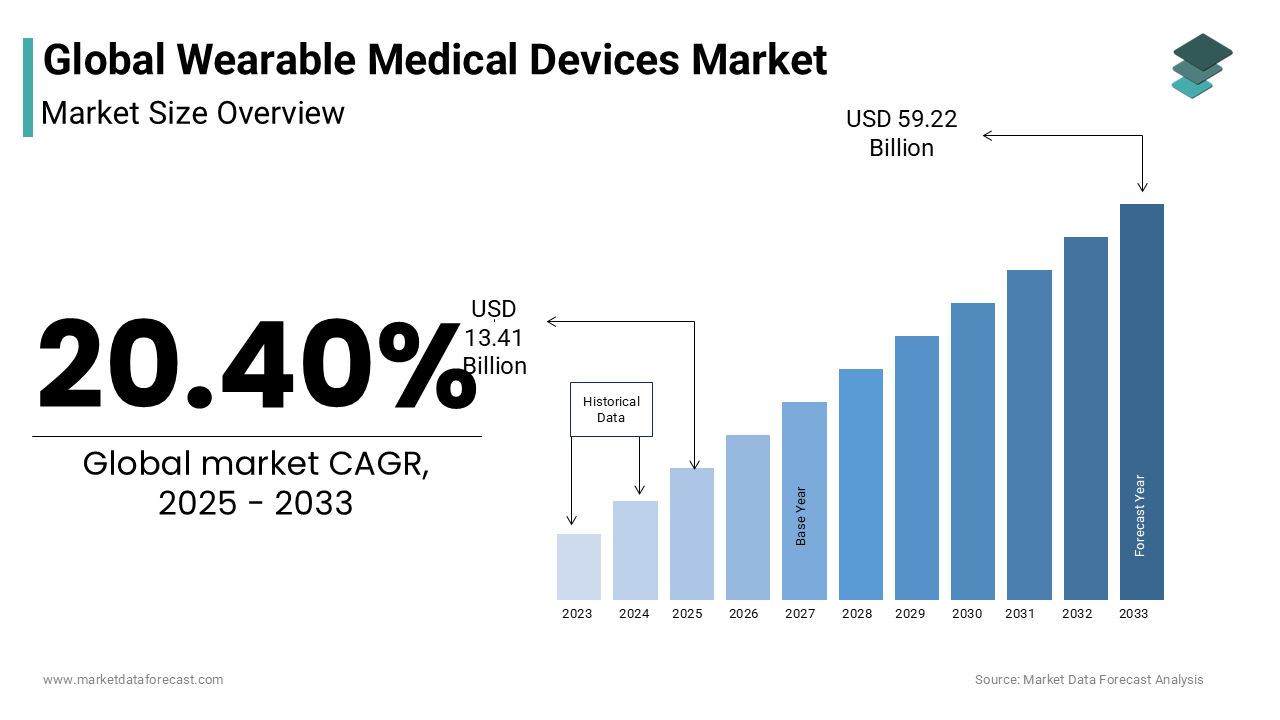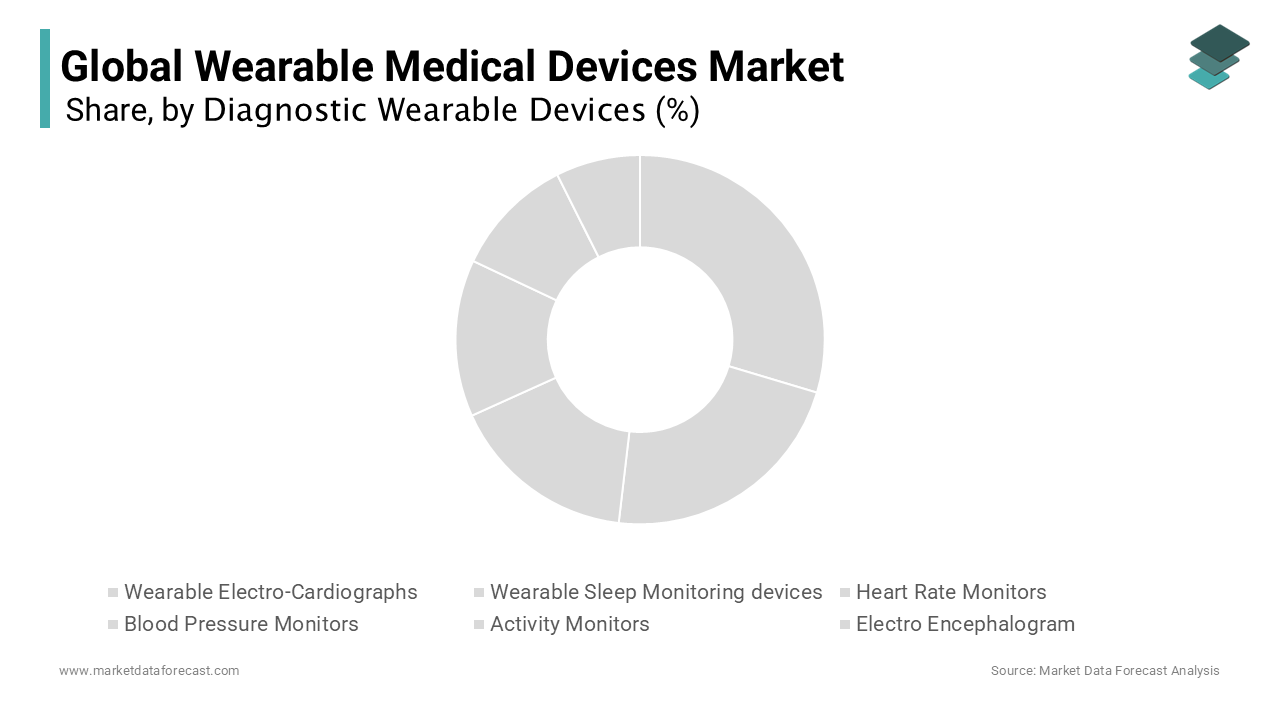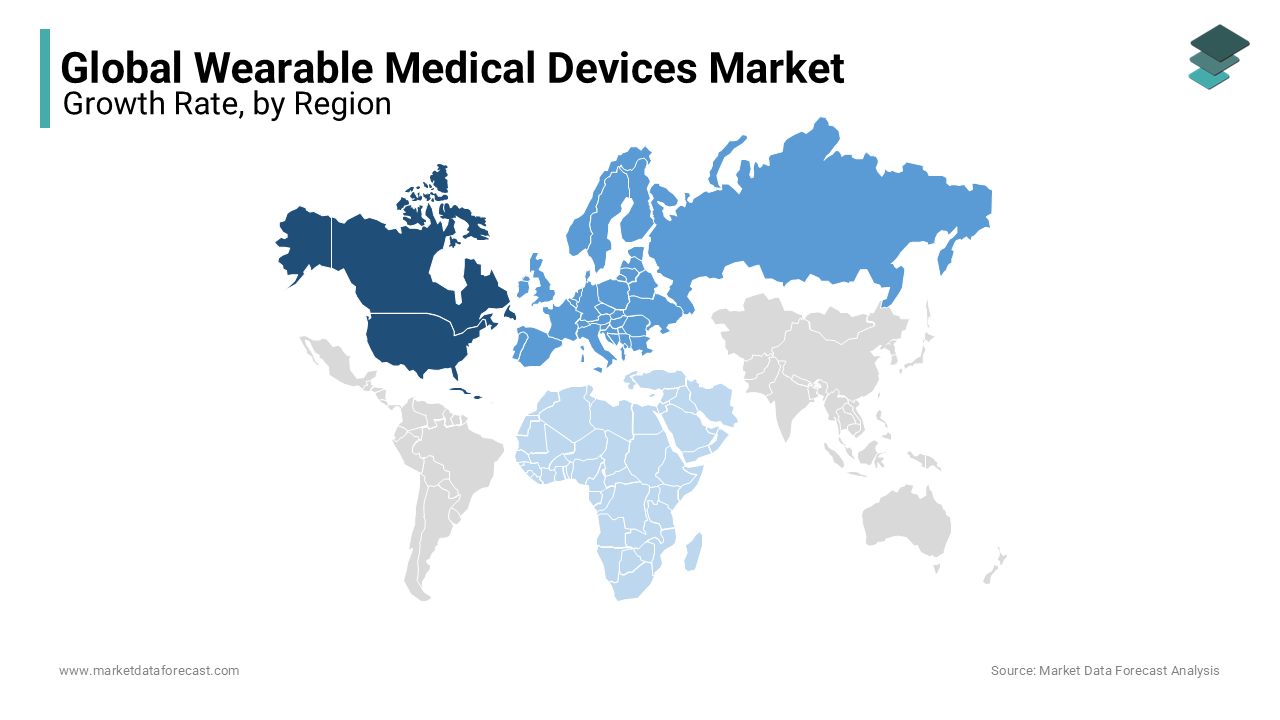Global Wearable Medical Devices Market Size, Share, Trends & Growth Forecast Report - Segmented By Diagnostic Wearable Devices (Wearable Electro-Cardiographs, Wearable Sleep Monitoring Devices, Heart Rate Monitors, Blood Pressure Monitors, Activity Monitors and Electro Encephalogram), Therapeutic Wearable Devices, Application & Region (North America, Europe, Asia-Pacific, Latin America, Middle East and Africa) - Industry Analysis From 2025 to 2033
Global Wearable Medical Devices Market Size
The global wearable medical devices market was valued at USD 11.14 billion in 2024. The size of the wearable medical devices market is forecasted to be worth USD 59.22 billion by 2033 from USD 13.41 billion in 2025. The market is growing at a remarkable compound annual growth rate (CAGR) of 20.40% from 2025 to 2033.

Wearable medical devices are electronic devices that help monitor a person's health and fitness condition. These devices can be worn on the body and are widely used for personal use or in clinical trials. Wearable medical devices collect health data that can be shared further with healthcare professionals. The collected data is helpful in the planning, diagnosing, and treatment of the person's health condition. Various applications of wearable medical devices, such as those used to help with rehabilitation and improve the person's healthcare, are escalating the adoption of these devices among people. The global wearable medical devices market has accounted for prominent growth in the past years and is anticipated to register notable growth during the forecast period. Wearable devices are mostly placed close to the skin or on the surface of the skin, which helps detect, analyze, and transmit information.
Wearable medical devices track physical activities, monitor heartbeats, and more. These devices are accurate in tracking physical fitness measurements while doing exercises. Wearable medical devices are comfortable, user-friendly, and opting as an option for home healthcare, increasing customers' focus on leading a healthy lifestyle and maintaining fit. It may become an extensive application in home healthcare, sports, and remote patient monitoring. Some of the wearable medical devices also show the calories burnt. The invention's design comes with sensors, software, and connectivity products. In the medical field, wearable medical devices play a vital role. These devices help to track several parameters like the patient's heartbeat and others. Also, it helps to improve the quality of care by the physicians, which provides health assessment. Wearable medical devices are more accurate and help individuals self-assess and promote earlier diagnosis.
MARKET DRIVERS
The growing customer preference for fitness apparel, primarily among young people, is accelerating the growth of the global wearable medical devices market.
Wearable medical devices are gaining popularity and improved technology by key market players due to increasing technological advancements and innovations. Wearable medical devices can connect with Android and IOS applications. As a result, a user can track physical fitness accurately; the global market for wearable medical devices is growing tremendously due to their convenient and reliable features. Increasing incidences of chronic diseases across the world, the rise in the utilization of smartphones and laptops, awareness of the Internet of things, and the increase in the concern towards health in many areas are accelerating the growth of the global wearable medical devices market.
The launch of wearable devices for various diseases like obesity, sleep apnea, diabetes, chronic obstructive pulmonary device, and others increases the demand for these products. In addition, the increasing prevalence of remote patient monitoring and personalized medicine globally is elevating the market's growth.
The growing adoption of technological advancements in manufacturing wearable medical devices and the increasing number of market participants are fuelling the market’s growth rate.
Many rising companies are now focusing on the wearable medical devices market, launching new products that are more fashionable, and helping encourage remote healthcare services. For example, A novel wearable gadget that enables remote patient monitoring was made commercially available by Golden, a Colorado-based BioIntelliSense Inc. Using the medical-grade BioButton Rechargeable gadget, more than 20 biometrics and vital signs may be continuously monitored remotely. Additionally, Sony, a consumer electronics manufacturer, entered the mobile health technology sector with a business-to-business wearables solution competing with Apple, Fitbit, etc. Sony introduced the mSafety platform at the Connected Health Conference in Boston, and a formal release of the product is scheduled for 2020. The device has features like remote health monitoring, mobile health apps, and a cloud-based backend. Solution. Furthermore, GOQii, a manufacturer of preventative healthcare equipment, unveiled its Smart Vital Ultra and GOQii Stream products to encourage young people and adults to live healthy and active lives.
MARKET RESTRAINTS
The high costs associated with these devices, as the advanced technology incorporation in the devices increases the overall cost of the product, limits its adoption among people with restricted budgets, and hampers market growth.
Another primary factor is data security, as these devices need adequate security features, which may lead to data breaches and access to unauthorized people, hindering the market growth rate. The need for awareness among the people and the concerns with the ease of use as the small displays act as challenging to use, especially for people with limited technology knowledge, is expected to limit the market growth. These devices hold most of the person's sensitive data, which raises security and privacy concerns and limits the adoption rate, leading to restricted market growth. The shorter battery life of the devices and continuous attachment of the device to the skin impede the market expansion. Due to higher complexity, the stringent regulations regarding wearable medical device approval and product launches are estimated to require more work for the manufacturers to expand the market revenue.
REPORT COVERAGE
|
REPORT METRIC |
DETAILS |
|
Market Size Available |
2024 to 2033 |
|
Base Year |
2024 |
|
Forecast Period |
2025 to 2033 |
|
Segments Covered |
By Diagnostic Wearable Devices, Therapeutic Wearable Devices, Applications, Region |
|
Various Analyses Covered |
Global, Regional & Country Level Analysis, Segment-Level Analysis; DROC, PESTLE Analysis; Porter's Five Forces Analysis, Competitive Landscape, Analyst Overview of Investment Opportunities |
|
Regions Covered |
North America, Europe, APAC, Latin America, Middle East & Africa |
|
Key Market Players |
Fitbit (United States), Philips (Netherlands), LifeWatch (Switzerland), Garmin (Switzerland), Omron (Japan), Drägerwerk (Germany), Nokia Technologies (United States), Jawbone (United States), Polar (Finland), Wor(l)d Global Network (United States), Active insights (United Kingdom), VitalConnect (United States), Xiaomi (China), Misfit (United States) and Monica Healthcare (United Kingdom) |
SEGMENTAL ANALYSIS
By Diagnostic Wearable Devices Insights

The blood pressure and activity monitor segments are projected to account for most of the wearable medical devices market during the forecast period. In addition, activity monitors help correct and real-time measurement of instructions required for controlling physical fitness, which allows the market to grow. Globally, the blood pressure monitor market is predicted to grow at a CAGR of 8.4% between 2025 and 2033.
The wearable electro-cardiograph segment has been severely impacted by the recent COVID-19 pandemic and is estimated to decline in its growing CAGR in a couple of years.
The wearable sleep monitoring devices segment is one of the lucrative segments and is predicted to register a CAGR of 14.5% during the forecast period. The demand for these products has grown significantly recently due to the technological advancements associated with these devices and their cost-friendliness.
The heart rate monitor segment is projected to grow at a CAGR of 15.2% during the forecast period. Increasing awareness of these devices and growing consciousness of heart health are majorly driving the segmental expansion.
By Therapeutic Wearable Devices Insights
The glucose/insulin monitoring devices segment is projected to continue their demand and are predicted to register a CAGR of 8.1% during the forecast period. In addition, the increasing number of patients with diabetes will increase the market's growth rate in the coming years.
The size of the pain management devices market is to hike at a CAGR of 9.1% during the forecast period and it is expected that the future for this segment will be more lucrative than in the past.
The respiratory therapy devices market segment is expected to register a healthy growth rate during the forecast period.
By Application Insights
The home healthcare segment for wearable medical devices is believed to have the highest share. It is expected to grow to produce profits during the analysis period. The increasing significance of home healthcare services is propelling the market growth.
The fitness and sports segment is anticipated to thrive in the upcoming years. Sports-related wearable devices like waistbands or skin patches use Bluetooth and GPS technology and provide real-time data. The growing tendency for sports and exercise activities also propels the market's growth rate. In addition, increasing awareness of maintaining a healthy lifestyle is likely to fuel the market's demand.
REGIONAL ANALYSIS

The North American region occupied the most significant share worldwide in 2024 and is anticipated to dominate throughout the forecast period. North America dominates the whole market for portable medical devices, with the United States becoming the main contributor to the market. North America has taken most of the market share and is expected to maintain its dominant position over the forecast horizon. Rising investments in healthcare centers by the government and the development of various devices with the latest technologies magnify the market demand. Also, increasing focus on leading healthy lifestyles by changing food habits and adopting fitness activities in daily life escalates the market demand in this region. The penetration rate of adult wearers in the United States was 15.5% in 2016, which increased to 20.3% in 2018 and is projected to increase to 25.3% by 2022, according to a 2019 report by Yoram Wurmser.
Europe accounted for a substantial share of the global market in 2024. Launching various feasible healthcare applications for smartphone users is broadening the market demand. Also, increasing demand for early diagnosis procedures is outshining the market's growth. The European market is also expected to witness growth due to the presence of key market players in the region and the rising awareness regarding the importance of remote healthcare and increasingly digitalizing populations in countries like the U.K., France, Germany, Italy, Etc. In addition, the market in Latin America, Middle East, and Africa is also showing growth, but the market has drawbacks in the region due to a lack of awareness.
Asia-Pacific is estimated to grow at the highest CAGR during the forecast period owing to the growing usage of wearable medical devices among the younger population, the rising geriatric population, and the device production rate.
Latin America is estimated to grow at a steady CAGR during the forecast period.
The wearable medical devices market in MEA is predicted to hold a moderate CAGR in the coming years.
KEY MARKET PLAYERS
Some of the most promising companies operating in the global wearable medical devices market profiled in the report are Fitbit (United States), Philips (Netherlands), LifeWatch (Switzerland), Garmin (Switzerland), Omron (Japan), Drägerwerk (Germany), Nokia Technologies (United States), Jawbone (United States), Polar (Finland), Wor(l)d Global Network (United States), Active insights (United Kingdom), VitalConnect (United States), Xiaomi (China), Misfit (United States) and Monica Healthcare (United Kingdom).
RECENT HAPPENINGS IN THE MARKET
- In October 2022, as part of its Series A funding round, the award-winning wearable medical device startup Acurable announced an investment of €11 million. These funds will quicken the international rollout of the company's initial product, the AcuPebble SA100, and get the business closer to its goal of becoming the go-to option for at-home sleep testing globally. Following the successful introduction of AcuPebble SA100 in the UK and Spain in 2021, Acurable seeks to increase its presence in these two nations and diversify into other European and North American markets. The AcuPebble SA100 is the first wearable medical device to get the FDA 510(k) clearance in the US and the CE mark in Europe for automated home diagnosis of obstructive sleep apnea.
- In October 2022, mjn-neuro, a startup that designs, manufactures, and markets medical devices, and Neuraxpharm Group (Neuraxpharm), a leading European specialty pharmaceutical company focused on the central nervous system (CNS), today announced the signing of a commercialization agreement for mjn-SERAS. This wearable medical device aims to predict the risk of having an epileptic seizure. All EU members, the UK, Norway, Iceland, Liechtenstein, and Switzerland, are included in the agreement with mjn-neuro. This is an important milestone for the business as it prepares to penetrate the markets for wearable medical devices and digital health.
- In October 2022, with its continuous glucose monitoring (CGM) technology, Dexcom became a pioneer in diabetes technology. Its newest Dexcom G7 CGM has already been sold in several foreign nations. However, the wearable device, which is 60% smaller than the G6 model, is still awaiting FDA approval.
MARKET SEGMENTATION
This research report on the global wearable medical devices market has been segmented and sub-segmented based on diagnostic wearable devices, therapeutic wearable devices, applications, and regions.
By Diagnostic Wearable Devices
- Wearable Electro-Cardiographs
- Wearable Sleep Monitoring devices
- Heart Rate Monitors
- Blood Pressure Monitors
- Activity Monitors
- Electro Encephalogram
By Therapeutic Wearable Devices
- Pain Management Devices
- Glucose/Insulin Monitoring Devices
- Respiratory Therapy Devices
By Application
- Sports and Fitness
- Home Healthcare
- Patient Monitoring
By Region
- North America
- Europe
- Asia-Pacific
- Latin America
- Middle East and Africa
Frequently Asked Questions
How much is the global wearable medical devices market going to be worth by 2033?
As per our research report, the global market size for wearable medical devices is estimated to be worth USD 59.22 Billion by 2033.
Does this report include the impact of COVID-19 on the wearable medical devices market?
Yes, in this report, the COVID-19 impact on the global wearable medical devices market is included.
Which region had the highest share of the wearable medical devices market in 2024?
Based on the region, the North American regional market led the wearable medical devices market in 2024.
Which are the significant players operating in the wearable medical devices market?
Fitbit (United States), Philips (Netherlands), LifeWatch (Switzerland), Garmin (Switzerland), Omron (Japan), Drägerwerk (Germany), Nokia Technologies (United States), Jawbone (United States), Polar (Finland), Wor(l)d Global Network (United States), Activeinsights (United Kingdom), VitalConnect (United States), Xiaomi (China), Misfit (United States) and Monica Healthcare (United Kingdom) are some of the notable companies operating in the wearable medical devices market.
Related Reports
Access the study in MULTIPLE FORMATS
Purchase options starting from
$ 2500
Didn’t find what you’re looking for?
TALK TO OUR ANALYST TEAM
Need something within your budget?
NO WORRIES! WE GOT YOU COVERED!
Call us on: +1 888 702 9696 (U.S Toll Free)
Write to us: sales@marketdataforecast.com
